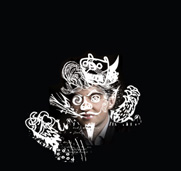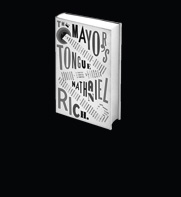Nathaniel Rich has written two novels:
The Mayor's Tongue (Riverhead, 2008) and the forthcoming Odds Against Tomorrow, which will be published by Farrar, Straus and Giroux in April 2013. He is also the author of a book on film noir, San Francisco
Noir (The Little Bookroom, 2005). He lives in New Orleans.
CONTACT:
Farrar, Straus and Giroux (publicity & rights inquiries): fsg dot publicity at fsgbooks dot
com
Nathaniel
Rich (everything else): nathaniel at nathanielrich dot com
Twitter: @nathanielrich
Q&A WITH NATHANIEL RICH ABOUT THE MAYOR'S TONGUE
Q: You kept the existence of
The Mayor’s Tongue secret during the five years you were
writing it. Why?
For a long time I thought it would be presumptuous
to announce that I was working on a novel. At no point was
I certain that all my notes and jottings would add up to a
finished novel, and there were times when I seriously doubted
the sanity, let alone the merits, of what I was writing. I
later found out that my suspicions were well-founded—when
I went back through the early drafts I realize that there were
more than a few ridiculous scenes and subplots, which
I ended up cutting before I showed the book to anyone. In the
end, though, I decided I was ready to take the next step, so
I gave the manuscript to a few friends. But only my nicest
friends.
Q: What led you to write it?
I had a lot of unformed ideas—about language, about
the way people relate to each other—that I wanted to
put on paper. The themes, the characters, and the general conceit
came first, the story later. In the first year or two I wrote
very little, but made notes about the characters and their
relationships. My thought—like my speech—is incoherent
to an embarrassing extent, and I can only make sense of what
I’m feeling or thinking about when I write it down. The
other thing—and I realize this is something of a cliché—was
that I wanted to write a story that I myself would enjoy reading.
Q: You’ve said that this book is extremely personal
but not autobiographical. How so?
Well, none of the events depicted in the book are real, except
perhaps for moments in which a male character humiliates himself
by being inarticulate in front of a girl. None of the characters
are stand-ins for me, and none of them—with the exception
of one or two very minor characters—are based on any
people I know in real life. But the book’s emotions are
very real to me, the themes and ideas are ones that I have
thought about obsessively, and the spirit and the tone of the
writing feels a reflection of my own sensibility.
I felt like I funneled all of my own personal thoughts into
some crazy contraption and, sausage-machine-style, out came The
Mayor’s Tongue.
Q: The failure of language is a central preoccupation
of your novel. How do you develop that theme?
The main characters all want urgently to communicate their
thoughts and emotions, but for different reasons, are unable
to do so. They develop all kinds of strategies, some of them
preposterous, but whether or not they succeed is open to interpretation.
I think this is something we all struggle with; at least I
do.
Q: There are two main stories that flow side by side
in your novel, but never actually intersect. Why did you
use this structure?
I had hoped that the two stories would generate some (perhaps
unconventional) suspense as they unfold, that the reader wouldn’t
be able to help but wonder what the two stories were going
to do. Even if that suspense is spoiled (by an interviewer’s
leading question, for instance), the fact is the characters
in both stories are faced with similar problems but they approach
them from their own perspectives, and reach different conclusions.
My hope is that the two stories reflect and echo each other
in different ways, and I felt that if they were to intersect,
it would cheapen that dialogue. I suppose there would be some
mild pleasure were Mr. Schmitz and Eugene to meet at the top
of a mountain in the Carso and hang out, but that would feel
to me a bit contrived and unnecessary. I think that, by the
end, the stories feel resolved in a way that is true to the
spirit of the novel.
Q: Your novel blends elements from many genres, including
fantasy, realism, mystery, fable, melodrama, and romance,
for starters. How do you describe the result?
I never thought in terms of genre, maybe because I don’t
have much experience in reading genre fiction, except for horror.
I worked hard to make the characters human, vivid, and honest.
It was important to me that the story move along at a steady
pace (this required a good amount of cutting and condensing
over the course of the writing process). I knew I wanted to
explore certain themes, so I concentrated on making those as
nuanced and involved as I could. I also knew from the very
beginning of the project that there would be some slightly
fantastical elements, but I wanted to work up to them gradually,
so that the reader was never jarred by some sudden plunge into
the surreal. I was thinking of a frog in slowly boiling water.
Q: You chose one of Italy’s least-known regions,
the Carso, as the setting for most of your book. Why?
The most prosaic reason is that I was living in Trieste the
summer I started writing the book. That summer, Trieste hosted
the annual international Esperanto festival, so everyone was
walking around speaking this invented language. And this in
a city where people speak a smattering of different tongues—Italian,
German, Slovenian, and Hungarian primarily, but also Triestino,
a thick dialect incomprehensible to other Italians. When you
go up into the Carso, this odd web of languages and cultures
becomes even more pronounced. On the winding mountain roads
it’s often difficult to tell what country you’re
in. The signs are all in different languages.
For a book whose central themes deal with the confusions brought
about by language, the Esperanto sealed the deal. But I also
loved the idea of this isolated land that nevertheless is located
within the borders of one of the most visited and familiar
countries in the world. The region is completely forgotten
by time, and even by its own country—I remember reading
a survey in which the majority of Italians thought that Trieste
wasn’t even part of Italy. It was only annexed in 1954,
and over history it has had numerous national and cultural
identities, having been under the rule of the Romans, Byzantines,
Slavs, the Austria-Hungarians; for several years after armistice
it was even an independent territory. It is the gateway to
the East, the easternmost city in Western Europe—but
it also could be considered the westernmost city in the East.
As Jan Morris wrote, it’s “nowhere.”
Q: Who are some of the writers who have influenced
your work?
I wonder whether there are any writers I love whom I haven’t
tried to steal from. Some of the writers whose work I repeatedly
consulted during the writing of the book were: Flann O’Brien,
Mikhail Bulgakov, Charles Dickens, Italo Svevo, Stephen King,
Kazuo Ishiguro, Katherine Dunn, and Arrian’s history
of Alexander the Great. Jan Morris’s excellent Trieste
and the Meaning of Nowhere was an important resource,
for her depiction of the city and its peculiar hazy identity.
Q: Are you working on another book? Can you say
anything about it?
The new novel has the working title of “Odds Against Tomorrow.”
|

